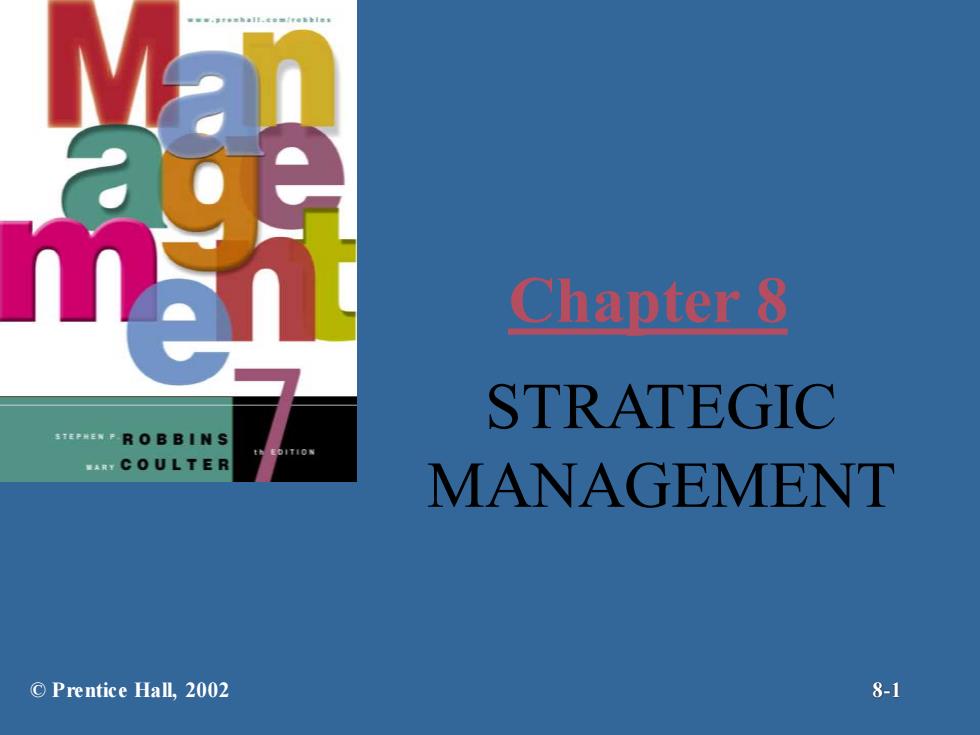
Chapter 8 STRATEGIO ROB B INS COULTER MANAGEMENT ©Prentice Hall,2002 8-1
Chapter 8 STRATEGIC MANAGEMENT © Prentice Hall, 2002 8-1
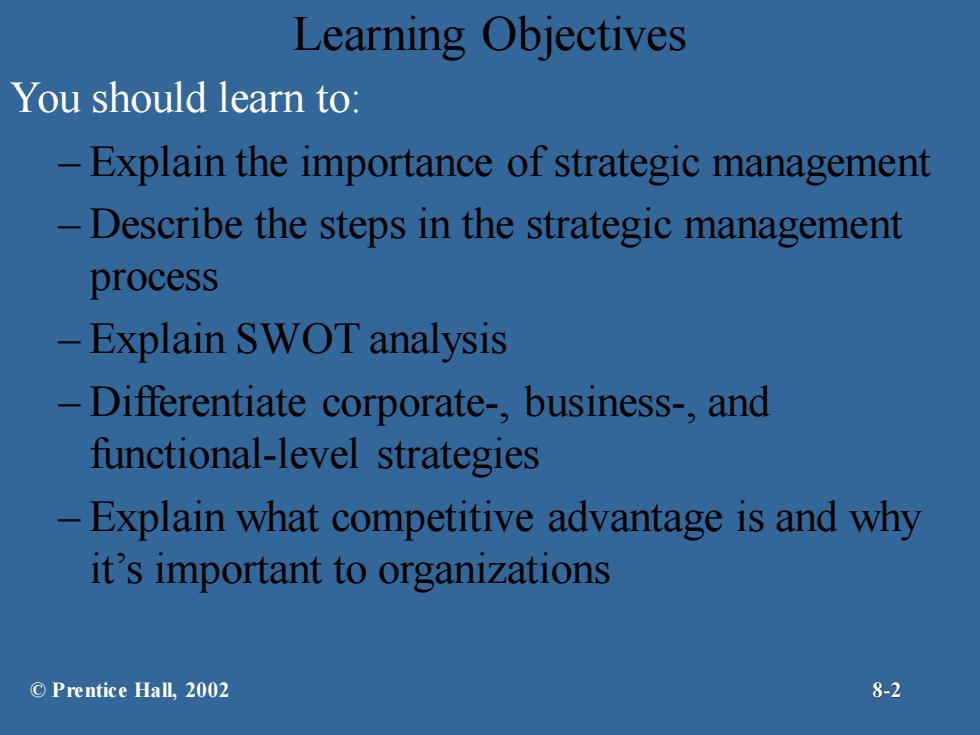
Learning Objectives You should learn to: Explain the importance of strategic management Describe the steps in the strategic management process Explain SWOT analysis Differentiate corporate-,business-,and functional-level strategies Explain what competitive advantage is and why it's important to organizations ©Prentice Hall,.2002 8-2
Learning Objectives You should learn to: – Explain the importance of strategic management – Describe the steps in the strategic management process – Explain SWOT analysis – Differentiate corporate-, business-, and functional-level strategies – Explain what competitive advantage is and why it’s important to organizations © Prentice Hall, 2002 8-2
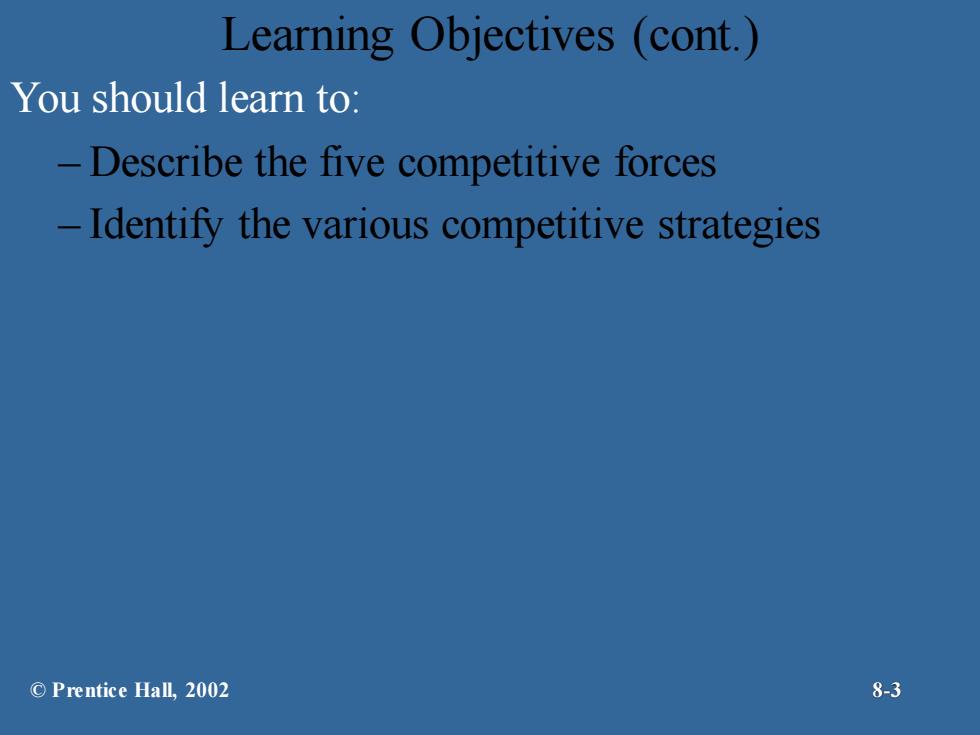
Learning Objectives (cont. You should learn to: -Describe the five competitive forces Identify the various competitive strategies ©Prentice Hall,.2002 8-3
Learning Objectives (cont.) You should learn to: – Describe the five competitive forces – Identify the various competitive strategies © Prentice Hall, 2002 8-3
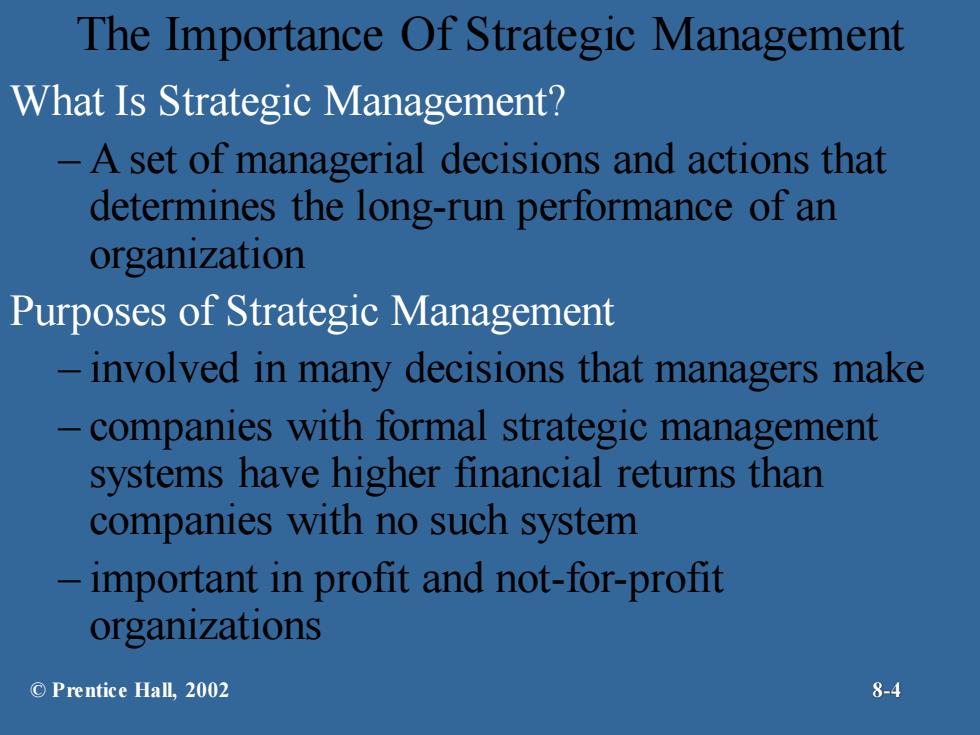
The Importance Of Strategic Management What Is Strategic Management? -A set of managerial decisions and actions that determines the long-run performance of an organization Purposes of Strategic Management - involved in many decisions that managers make companies with formal strategic management systems have higher financial returns than companies with no such system important in profit and not-for-profit organizations ©Prentice Hall,2002 8-4
The Importance Of Strategic Management What Is Strategic Management? – A set of managerial decisions and actions that determines the long-run performance of an organization Purposes of Strategic Management – involved in many decisions that managers make – companies with formal strategic management systems have higher financial returns than companies with no such system – important in profit and not-for-profit organizations © Prentice Hall, 2002 8-4
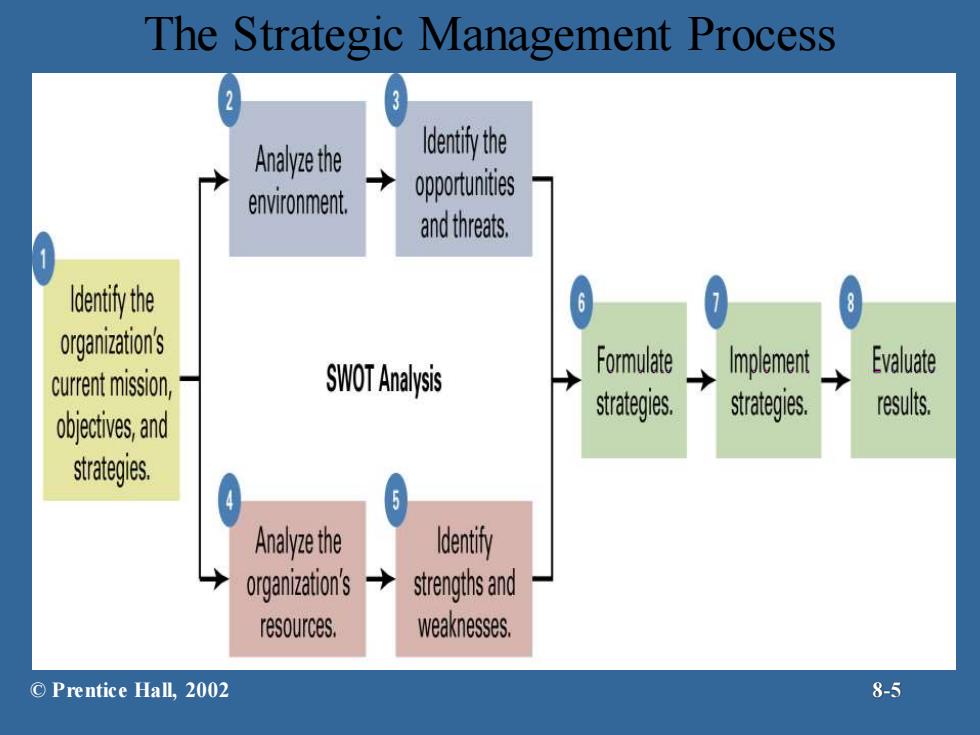
The Strategic Management Process Analyze the deni the environment. oppoitunities and threats. dentifythe organization's SWOTAnalysis Formulate mplement Evaluate current mission, strategs strateg results. biv,and strategis. Analyze the denti organization's → strngand resources. weaknesses. ©Prentice Hall,2002 8-5
The Strategic Management Process © Prentice Hall, 2002 8-5
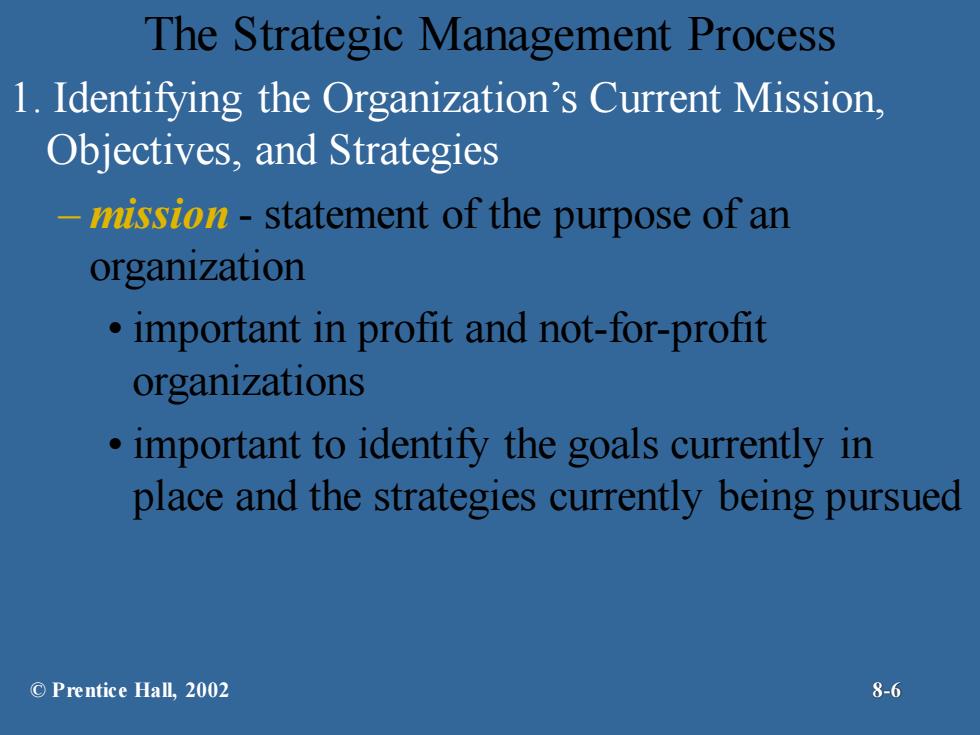
The Strategic Management Process 1.Identifying the Organization's Current Mission, Objectives,and Strategies maission-statement of the purpose of an organization important in profit and not-for-profit organizations important to identify the goals currently in place and the strategies currently being pursued ©Prentice Hall,2002 8-6
The Strategic Management Process 1. Identifying the Organization’s Current Mission, Objectives, and Strategies – mission - statement of the purpose of an organization • important in profit and not-for-profit organizations • important to identify the goals currently in place and the strategies currently being pursued © Prentice Hall, 2002 8-6
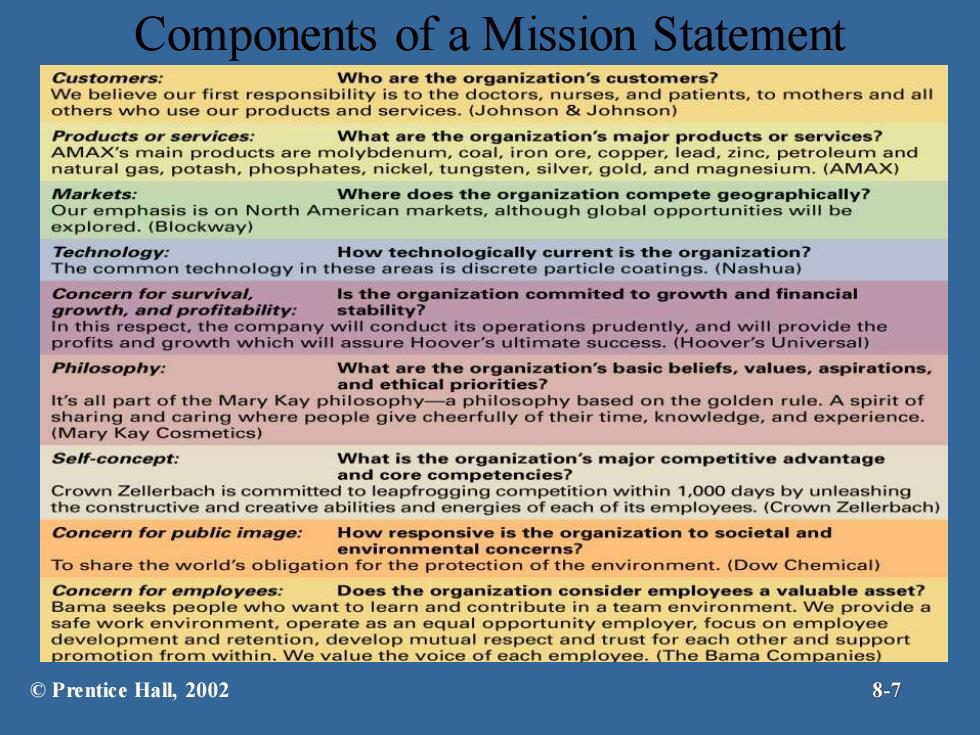
Components of a Mission Statement Customers: Who are the organization's customers? We believe our first responsibility is to the doctors,nurses,and patients,to mothers and all others who use our products and services.(Johnson Johnson) Products or services: What are the organization's major products or services? AMAX's main products are molybdenum,coal,iron ore,copper,lead,zinc,petroleum and natural gas,potash,phosphates,nickel,tungsten,silver,gold,and magnesium.(AMAX) Markets: Where does the organization compete geographically? Our emphasis is on North American markets,although global opportunities will be explored.(Blockway) Technology: How technologically current is the organization? The common technology in these areas is discrete particle coatings.(Nashua) Concern for survival, Is the organization commited to growth and financial growth,and profitability: stability? In this respect,the company will conduct its operations prudently,and will provide the profits and growth which will assure Hoover's ultimate success.(Hoover's Universal) Philosophy: What are the organization's basic beliefs,values,aspirations, and ethical priorities? hamngearinwhere popv heyhumenowioge andxpenenco It's all part of the Mary Kay philosophy- (Mary Kay Cosmetics)】 Self-concept: What is the organization's major competitive advantage and core competencies? Crown Zellerbach is committed to leapfrogging competition within 1,000 days by unleashing the constructive and creative abilities and energies of each of its employees.(Crown Zellerbach) Concern for public image: How responsive is the organization to societal and environmental concerns? To share the world's obligation for the protection of the environment.(Dow Chemical) Concern for employees: Does the organization consider employees a valuable asset? Bama seeks people who want to learn and contribute in a team environment.We provide a safe work environment,operate as an equal opportunity employer,focus on employee development and retention,develop mutual respect and trust for each other and support promotion from within.We value the voice of each employee.(The Bama Companies) ©Prentice Hall,2002 8-7
Components of a Mission Statement © Prentice Hall, 2002 8-7
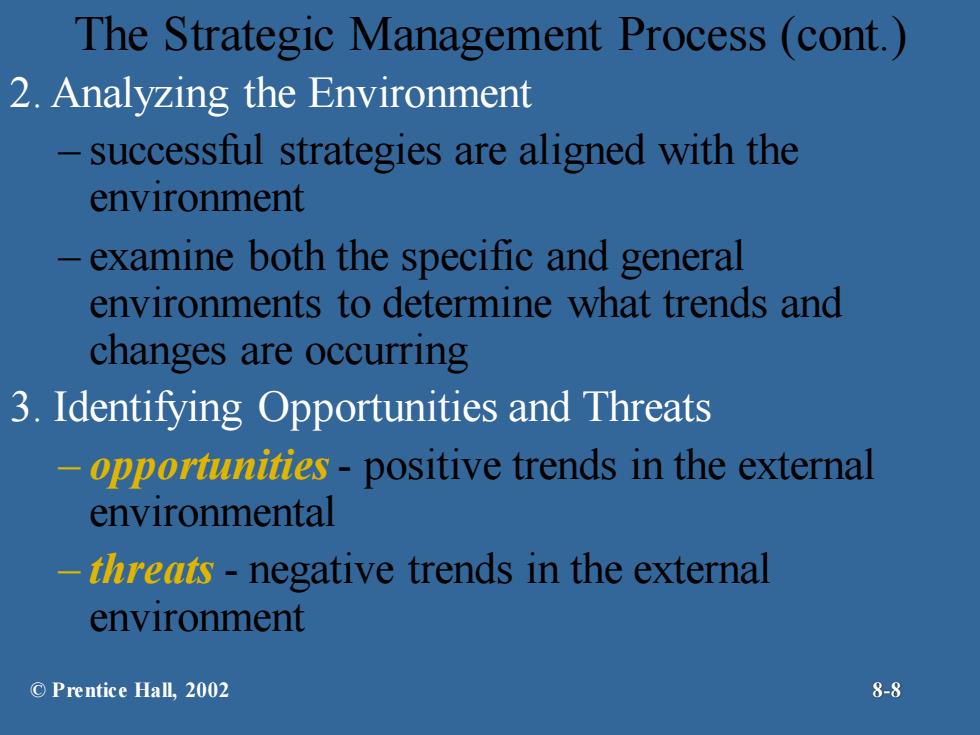
The Strategic Management Process (cont.) 2.Analyzing the Environment successful strategies are aligned with the environment examine both the specific and general environments to determine what trends and changes are occurring 3.Identifying Opportunities and Threats opportities-positive trends in the external environmental dbreaky-negative trends in the external environment ©Prentice Hall,.2002 8-8
The Strategic Management Process (cont.) 2. Analyzing the Environment – successful strategies are aligned with the environment – examine both the specific and general environments to determine what trends and changes are occurring 3. Identifying Opportunities and Threats – opportunities- positive trends in the external environmental – threats - negative trends in the external environment © Prentice Hall, 2002 8-8
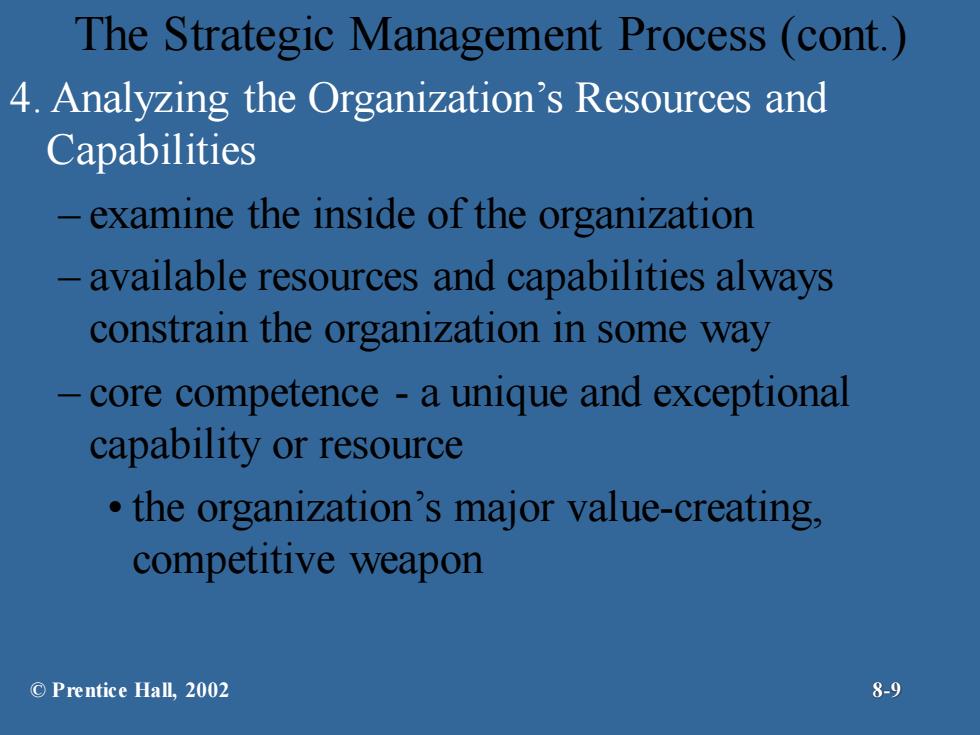
The Strategic Management Process (cont. 4.Analyzing the Organization's Resources and Capabilities examine the inside of the organization -available resources and capabilities always constrain the organization in some way -core competence -a unique and exceptional capability or resource the organization's major value-creating, competitive weapon ©Prentice Hall,2002 8-9
The Strategic Management Process (cont.) 4. Analyzing the Organization’s Resources and Capabilities – examine the inside of the organization – available resources and capabilities always constrain the organization in some way – core competence - a unique and exceptional capability or resource • the organization’s major value-creating, competitive weapon © Prentice Hall, 2002 8-9
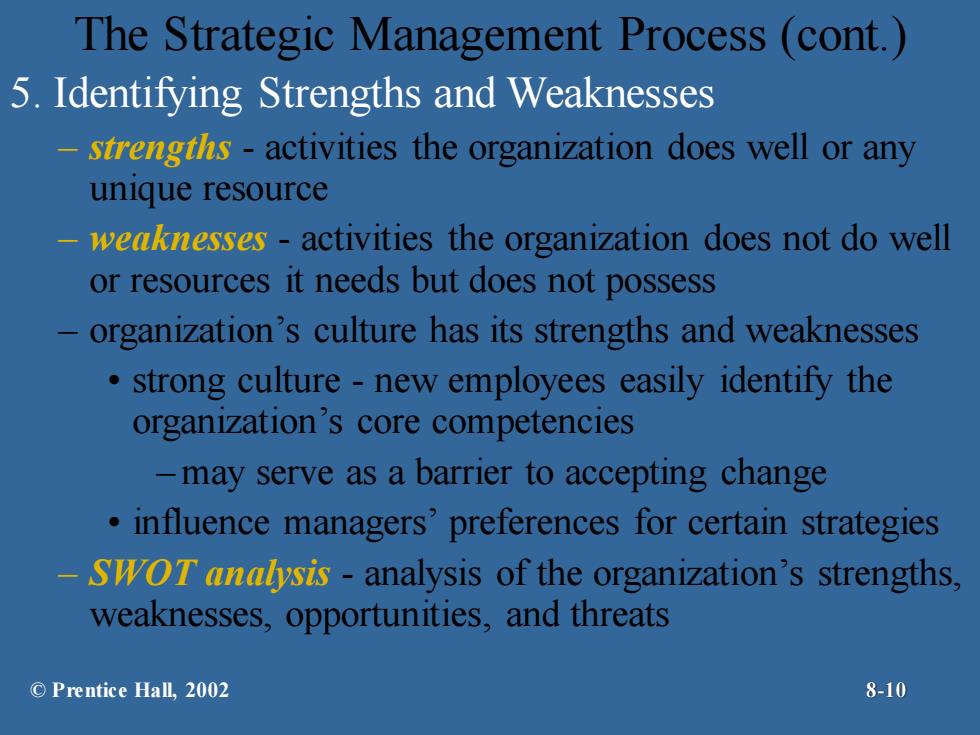
The Strategic Management Process (cont.) 5.Identifying Strengths and Weaknesses strengdbs-activities the organization does well or any unique resource weaknesses-activities the organization does not do well or resources it needs but does not possess organization's culture has its strengths and weaknesses strong culture-new employees easily identify the organization's core competencies may serve as a barrier to accepting change - influence managers'preferences for certain strategies -SWOT analiysis-analysis of the organization's strengths, weaknesses,opportunities,and threats ©Prentice Hall,.2002 8-10
The Strategic Management Process (cont.) 5. Identifying Strengths and Weaknesses – strengths - activities the organization does well or any unique resource – weaknesses - activities the organization does not do well or resources it needs but does not possess – organization’s culture has its strengths and weaknesses • strong culture - new employees easily identify the organization’s core competencies –may serve as a barrier to accepting change • influence managers’ preferences for certain strategies – SWOT analysis - analysis of the organization’s strengths, weaknesses, opportunities, and threats © Prentice Hall, 2002 8-10